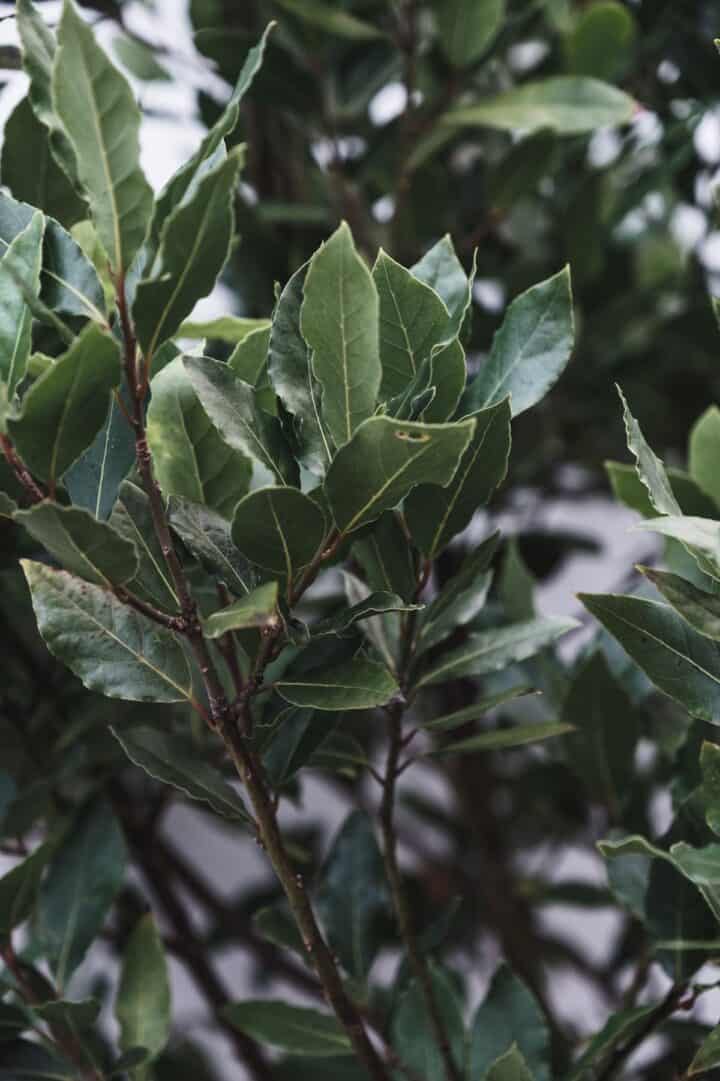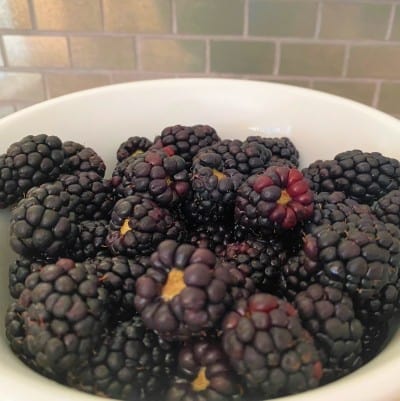Bay leaves may not be as trendy as turmeric, but this savory herb is like an old friend who is always there for you. Its depth of flavor never lets you down when added to soups, stews, braises, sauces, and more. 🍲
In addition to enhancing the taste of many different cookery creations, use of bay leaves can boost your health. Traditional and herbal medicine employ this aromatic leaf as an antioxidant/anti-inflammatory for healing.
Learn how to make bay leaf tea in the five-minute tea recipe below. Sip and savor the soothing qualities and pleasant aroma of this essential winter tastemaker.

Would you like to save this recipe or article?
You won't get spam from me, I promise!
Cooking with bay leaves
If you bite into a bay leaf, the taste is bitter and unappealing, and munching on whole bay leaves is not how to enjoy the herb. Simmer it in hearty winter ragouts and stews to impart a subtle flavor that is herbal, woody, and almost sweet.
Leaves are generally added to culinary creations that need a long cooking time.
Heat releases complex flavors and aromas that are herbaceous, spicy, woody, floral, refreshing, and bitter-sweet.
Use a dried or fresh leaves in any of the following:
- Stews
- Soups
- Stocks
- Court bouillons (fish)
- Beans and pulses
- Braises with sturdy vegetables
- Poaching liquid
Bouquet Garni
Bay leaves are often combined with other spices in a bouquet garni, a whole herb bundle tied with cooking twine or wrapped in cheesecloth that infuses flavor into the cooking liquid.

It's easy to remove when the dish is ready for serving.
Here’s how to make one.
Ingredients:
- 1 large or 2 small to medium bay leaves
- 1 sprig of thyme
- 2 sprigs of parsley
- 1 sprig of rosemary
Make a bundle with the herbs and tie with a piece of twine. Add to your favorite stew or hearty soup at the beginning of the cooking process to deepen the flavor.
Alternatively, cut a piece of cheesecloth to craft a pouch that will hold the herbs. With the pouch, you can add loose seasonings, such as peppercorns, cloves, celery or coriander seeds, star anise.
The cheesecloth keeps the whole spices contained so they aren't floating around in the cooking liquid.
Bay leaf powder
Powder made from ground bay leaves can be substituted for whole. Use ¼ teaspoon for one dried bay leaf. Use ½ teaspoon to replace a fresh bay leaf.
Powder is nice if you don’t want to fish out the bay leaf after cooking.

The powder works well in spice blends like the Old Bay seasoning used in chowder and on many types of seafood. It may find its way into garam masala, the Indian spice mix, or Filipino adobo, and can add a dark flavor note to spice rubs.
Whip up your own in a spice grinder or small coffee bean grinder. Use about 20 bay leaves for 2 Tablespoons of powder. Of course, you may need a few more or less depending on the size of your leaves.
Types of Bay Leaves
There are many different varieties of bay laurel trees. In the U.S., you’ll often find the California bay leaf, from the Umbellularia californica, and the Turkish bay leaf, from Laurus nobilis.

The name of the latter may refer to the use of bay leaves as crowns by the ancient Greeks and in Roman times. They are particularly associated with the Temple of Apollo in Delphi.
The temple’s attendants were said to eat or chew bay leaves to boost their psychic powers and give them prophetic dreams. Bay leaves may have some narcotic effects and are known to slow the central nervous system in large quantities.
Sleeping with the bay leaves was supposed to make a man a poet.
The leaves can taste a bit different depending on which type of bay laurel tree produced them. India is the largest exporter of bay leaves to the U.S. with China ranking close behind. Turkey is the fourth-largest exporter.
Indian bay leaves have some flavor notes of cinnamon. Turkish leaves are milder, particularly when compared to leaves from California, which may have stronger eucalyptus qualities.
Keep in mind that these are small variances, and usually, the varieties may be used interchangeably.
FAQs⁉️
No, but they are a choking hazard.
Use either in a recipe, but know that fresh will have a gutsier flavor, and may need earlier removal in cooking. (Dried are usually taken out at the end of the cook time, before serving.)
Most recipes only need a single large leaf or two small ones.
No. Although this releases more flavor and healthful compounds, it makes them more difficult to remove and could pose a choking hazard. If you are using a cheesecloth bouquet garni, you could crumble the leaf before adding.
Another way to get maximum flavor from the leaf would be to snap it in half. It’s still easy to fish out of the cooking liquid but will release more of its goodness into the dish.
Bay leaf storage
Dried bay leaves have good flavor for six months to a year. They are safe to use after a year, but you may want to use an extra one or two to intensify the taste. They do not “go bad.”
On the other hand, fresh bay leaves can rot. So, store them in the refrigerator either in a plastic bag or (affiliate link) produce storage bag with holes to allow for air flow. They may last three days to two weeks.
🧊For longer storage, you can freeze them in an airtight zip bag. Dried bay leaves can also be frozen to preserve their best taste.
Myriad health benefits of bay leaves 💪🏼
A plethora of spices contain phytochemicals effective against a range of chronic ailments and bay leaves are no exception.
Yet, despite some promising studies, the body of research on them is small and has rarely included human subjects. So, it’s important not to expect the use of bay leaves alone to function as a panacea for various ailments.
That said, akin to turmeric and other herbs and spices, small amounts used regularly in cooking may contribute to health.
Bay leaves have been used for centuries in many medical traditions.
- Digestion: For thousands of years, healers have turned to bay leaves to reduce bloating and gas and ease digestive discomfort. See the recipe for bay leaf tea at the end of this post!
- Blood sugar management: Two recent studies, one with animals and one with humans, indicate that bay leaves could possibly help with insulin sensitivity and keeping blood glucose in a healthy range.
- Antibacterial, antifungal, and antiviral: Most plants have natural defenses that ward off pests including microscopic bacteria and fungi. The pungent essential oils in bay leaves may help with preserving food.
- Antioxidants: These substances scavenge free radicals that cause disrepair and cellular dysfunction. Flavonoids and polyphenols found in bay leaves act in this way and could possibly help with aging, cancer, and general health.
Anti-inflammatory mechanisms
There are at least 3 specific terpenes, beneficial aromatic compounds, in bay leaves.
- Cineole, also called eucalyptol, reduces inflammation and is an antioxidant.
- Myrcene is an anti-inflammatory and pain-reliever also found in cannabis.
- Linalool is another anti-inflammatory that may also help with anxiety. You’ll also smell it in other aromatic plants, including lavender.
Eugenol is not a terpene, but is an antioxidant and anti-inflammatory also present in cloves, cinnamon, basil, and other herbs and spices. Discover its sweetness in this recipe for Lemon Basil Vinaigrette.
👃🏼Pinene has benefits for respiratory ailments. This anti-inflammatory compound acts as a bronchodilator, helping to open the sinuses. Bay leaf poultice on the chest is an old remedy to help with colds and congestion.
💗Cardiovascular system benefits
Many of the health-enhancing virtues of bay leaves are derived from the anti-inflammatory, antioxidant characteristics of the herb.
Heart disease: Oxidative stress and inflammation can promote heart disease. The flavonoid and phenol phytochemicals in bay leaves have antioxidants/anti-inflammatory effects that may help reduce the risk.
Cholesterol: According to studies, they can lower LDL (bad) cholesterol and increase HDL (good) cholesterol, which may lower the risk for the build-up of plaque in blood vessels.
Blood pressure: Bay leaf tea reduced blood pressure in a human study published in 2021*. The authors say that flavonoid antioxidants in bay leaves may have a vasodilation effect.
*Budiman; Erisandi, T. The Difference of Celery Leaves And Bay Leaves Water to Decrease Blood Pressure among Pre-Elderly With Primary Hypertension in Public Health Center Cigugur Tengah. Jurnal Keperawatan Komprehensif, Vol. 7 No.2 July 2021
Other studies and disease interventions with bay leaves
Recently, bay leaf extract was found to reduce the risk for kidney stones related to lowered production of the enzyme urease. The extract was combined with several other herbs used in traditional medicine.
Bay leaf extract facilitated wound healing in an animal study from 2006.
Bay leaves have long been used in herbal medicine for a wide variety of ailments including rheumatism, sprains, earaches, migraines, and to increase sweat production.
⚠️Cautions and concerns
Pregnancy and breastfeeding: Do not use bay leaves as medicine as they have not been studied . It’s possible that it could have a stimulating effect on the uterus.
Anyone considering the use of bay leaves as medicine should first consult with their healthcare provider.
The small amount of bay leaves used in foods should not pose any problems and may promote overall wellbeing.
🍃Bay Leaf Nutrients
The leaves contain an abundance of minerals.
- Calcium
- Manganese
- Potassium
- Magnesium
- Iron
They are also a good source of:
- Fiber
- Vitamin B6
- Folate
- Vitamin A
- Vitamin C
Source: USDA database
Bear in mind that most bottles or bags of leaves available for sale contain far less than an ounce, and a single leaf or two used in cooking will have a fraction of these nutrients.
Punching up the flavor of your food with herbs and spices benefits both your palate and health. Find out more about them in my Garlic Goodness article and Mediterranean Herbs and Spices by RDN Grace Rivers.
(Grace and fellow RDN Stephanie Turkel have reccently published a new women's nutrition and wellness guidebook, Advancing to a Healthier You.)
Bay leaf tea is a soothing and simple way to add bay leaves to your health.

Add a cinnamon stick during the steeping time and you may reap extra benefits in taste and blood sugar management!

Bay Leaf Tea
Equipment
- Tea filter
- Tea strainer
Ingredients
- 3 dried bay leaves , crushed
- 8 ounces water
- 1 teaspoon honey , optional
- 1 slice lemon , optional
Instructions
- Crumble the bay leaves to release more flavor and healthful compounds.
- Pack the crumbled leaves into a tea filter or tea infuser with a clasp and place in a cup.
- Bring the water to a boil perhaps in an electric kettle and pour over the crumbled bay leaves.
- Let the leaves steep for 5 to 10 minutes. The longer they sit in the water, the stronger the tea will taste.
- Remove the tea filter or tea infuser. Add honey and lemon, if desired and sip as desired.






Leave a Reply